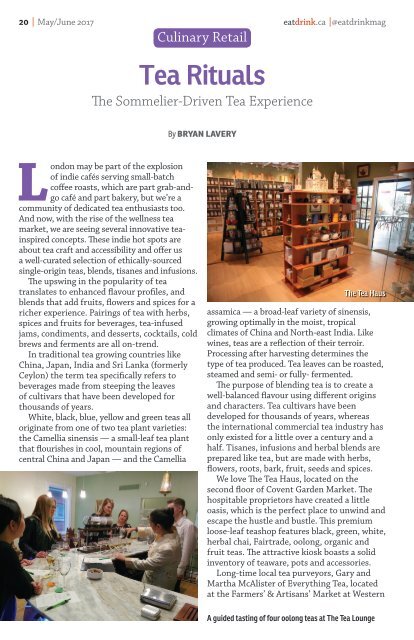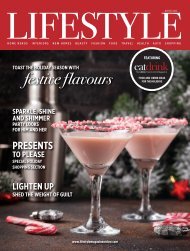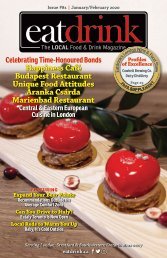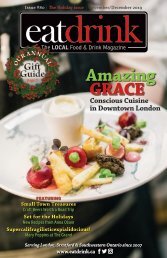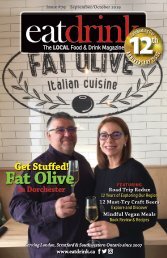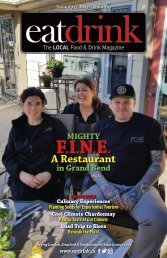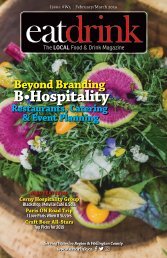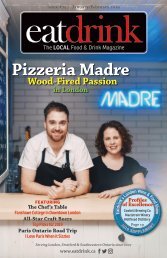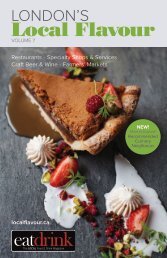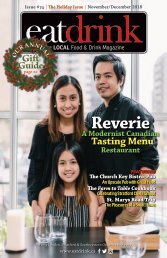Eatdrink #65 May/June 2017
The LOCAL food and drink magazine serving London, Stratford & Southwestern Ontario since 2007
The LOCAL food and drink magazine serving London, Stratford & Southwestern Ontario since 2007
Create successful ePaper yourself
Turn your PDF publications into a flip-book with our unique Google optimized e-Paper software.
20 | <strong>May</strong>/<strong>June</strong> <strong>2017</strong><br />
Culinary Retail<br />
Tea Rituals<br />
The Sommelier-Driven Tea Experience<br />
eatdrink.ca |@eatdrinkmag<br />
By BRYAN LAVERY<br />
London may be part of the explosion<br />
of indie cafés serving small-batch<br />
coffee roasts, which are part grab-andgo<br />
café and part bakery, but we’re a<br />
community of dedicated tea enthusiasts too.<br />
And now, with the rise of the wellness tea<br />
market, we are seeing several innovative teainspired<br />
concepts. These indie hot spots are<br />
about tea craft and accessibility and offer us<br />
a well-curated selection of ethically-sourced<br />
single-origin teas, blends, tisanes and infusions.<br />
The upswing in the popularity of tea<br />
translates to enhanced flavour profiles, and<br />
blends that add fruits, flowers and spices for a<br />
richer experience. Pairings of tea with herbs,<br />
spices and fruits for beverages, tea-infused<br />
jams, condiments, and desserts, cocktails, cold<br />
brews and ferments are all on-trend.<br />
In traditional tea growing countries like<br />
China, Japan, India and Sri Lanka (formerly<br />
Ceylon) the term tea specifically refers to<br />
beverages made from steeping the leaves<br />
of cultivars that have been developed for<br />
thousands of years.<br />
White, black, blue, yellow and green teas all<br />
originate from one of two tea plant varieties:<br />
the Camellia sinensis — a small-leaf tea plant<br />
that flourishes in cool, mountain regions of<br />
central China and Japan — and the Camellia<br />
The Tea Haus<br />
assamica — a broad-leaf variety of sinensis,<br />
growing optimally in the moist, tropical<br />
climates of China and North-east India. Like<br />
wines, teas are a reflection of their terroir.<br />
Processing after harvesting determines the<br />
type of tea produced. Tea leaves can be roasted,<br />
steamed and semi- or fully- fermented.<br />
The purpose of blending tea is to create a<br />
well-balanced flavour using different origins<br />
and characters. Tea cultivars have been<br />
developed for thousands of years, whereas<br />
the international commercial tea industry has<br />
only existed for a little over a century and a<br />
half. Tisanes, infusions and herbal blends are<br />
prepared like tea, but are made with herbs,<br />
flowers, roots, bark, fruit, seeds and spices.<br />
We love The Tea Haus, located on the<br />
second floor of Covent Garden Market. The<br />
hospitable proprietors have created a little<br />
oasis, which is the perfect place to unwind and<br />
escape the hustle and bustle. This premium<br />
loose-leaf teashop features black, green, white,<br />
herbal chai, Fairtrade, oolong, organic and<br />
fruit teas. The attractive kiosk boasts a solid<br />
inventory of teaware, pots and accessories.<br />
Long-time local tea purveyors, Gary and<br />
Martha McAlister of Everything Tea, located<br />
at the Farmers’ & Artisans’ Market at Western<br />
A guided tasting of four oolong teas at The Tea Lounge


